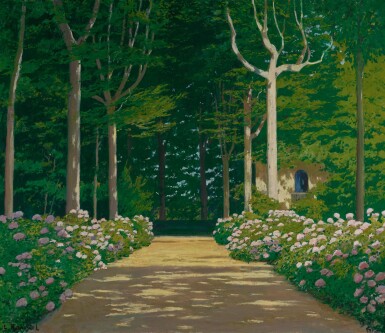19th Century European Paintings
19th Century European Paintings

Property from an English Private Collection
SANTIAGO RUSIÑOL | Caminal d'hortènsies (Hydrangeas on a Garden Path)
Auction Closed
December 11, 03:18 PM GMT
Estimate
100,000 - 150,000 GBP
Lot Details
Description
Property from an English Private Collection
SANTIAGO RUSIÑOL
Spanish
1861 - 1931
Caminal d'hortènsies (Hydrangeas on a Garden Path)
signed S. Rusiñol lower left
oil on canvas
98.5 by 115cm., 38¾ by 45¼in.
Josep de C. Laplana, Santiago Rusiñol: El pintor, l'home, Barcelona, 1995, p. 577, no. 2.
Josep de C. Laplana & Mercedes Palau-Ribes O'Callaghan, La pintura de Santiago Rusiñol. Obra completa, Barcelona, 2004, vol. I, p. 176, cited; vol. III, p. 202, no. 20.1.10, catalogued & illustrated (as Caminal d'hortènsies)
Painted in 1929, this haunting vista of borders of pink hydrangeas along a wooded path shaded by a verdant canopy was painted in the Parc Badés in Arbúcies, a town lying some fifty kilometres to the northeast of Barcelona. The gardens of the Casa Badés became the subject of no fewer than fifteen of Rusiñol's paintings between 1927 and 1929.
The present work was one of four canvases by Rusiñol included in the Royal Academy's recent exhibition Painting the Modern Garden: Monet to Matisse, together with two by the artist's fellow Catalan painter Joaquim Mir. Of Rusiñol, Heather Lemonedes wrote in the catalogue: 'Rusiñol's dedication to the theme of the garden was matched by few other artists. A trip to Granada in 1898 seems to have been pivotal for the Catalan painter-poet...It has been suggested that the garden provided a refuge from his melancholic personality and morphine addiction, and that the empty garden became a metaphor for the artist's inner world; but painting the abandoned gardens of the aristocracy may have also been an expression of Spain's decline following defeat in the Spanish-American War of 1898.'
The charismatic leader of Catalan Modernism, and a founder of Els Quatre Gats in Barcelona, Rusiñol travelled widely and spent extended periods in Paris. Notwithstanding his position as a leading member of the international avant-garde, however, it was in Spain, away from the clamour of the Parisian metropolis, that he was able to explore the full range of his resonant palette and where many of his most powerful and evocative works were completed.
